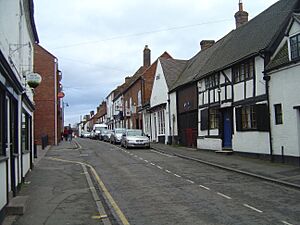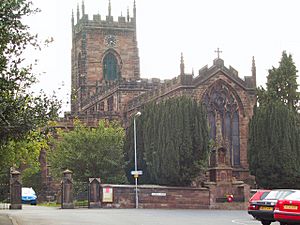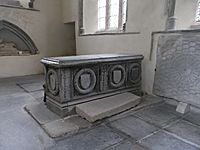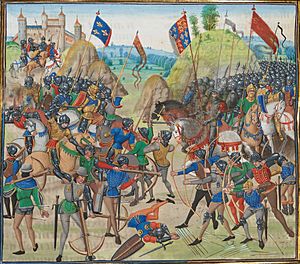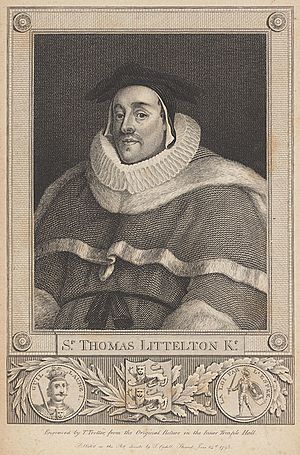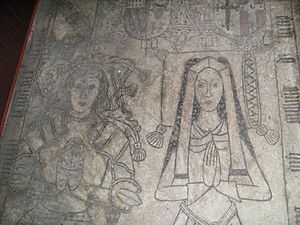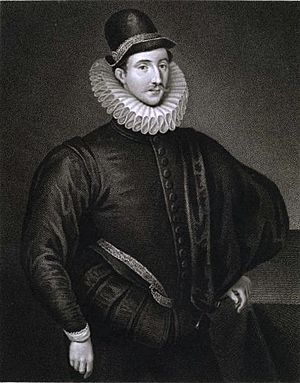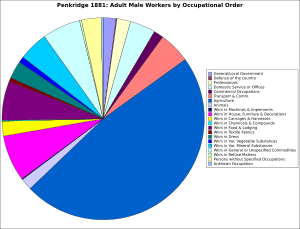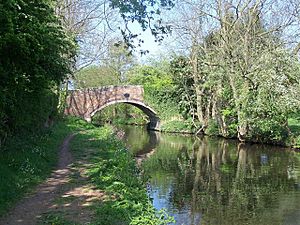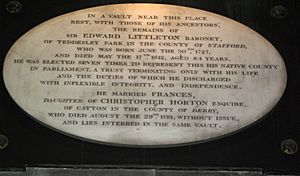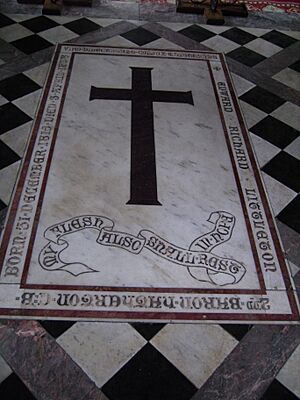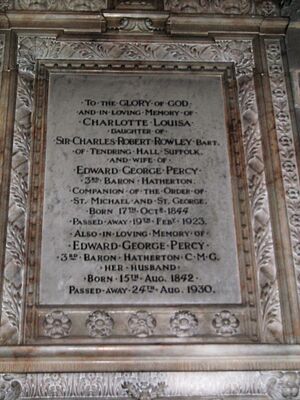History of Penkridge facts for kids
Penkridge is a village and parish in Staffordshire, England, with a long history going back to the Anglo-Saxon period. It was an important place for both religion and trade. The village first grew around the Collegiate Church of St. Michael and All Angels. This church was special because it was a "chapel royal," meaning it belonged directly to the king and was independent from the local bishop until the Reformation.
Penkridge is even mentioned in the Domesday Book, a famous survey from 1086. From the 1200s, the village started to grow as strict "Forest Laws" were relaxed. It became a mix of different "manors" (areas of land controlled by a lord), mostly focused on farming. From the 1500s, one powerful family, the Littletons, became very important in Penkridge. They eventually became "Barons Hatherton" and helped improve farming and schools in the area. The Industrial Revolution brought better transport and communication, shaping the modern village. In the second half of the 1900s, Penkridge grew quickly, becoming a place where many people live, but it still kept its shops, its connection to the countryside, and its beautiful church.
Contents
Early Days of Penkridge
People have lived in the area around Penkridge for a very long time. We know this because a Bronze or Iron Age burial mound (called a barrow) was found nearby at Rowley Hill. A significant settlement existed here even before the Romans arrived. Its first location was where the River Penk met the Roman military road, now known as the A5. This spot was between Water Eaton and Gailey, about 2.25 miles (3.6 km) southwest of the modern village.
Anglo-Saxon Beginnings
The village of Penkridge, where it stands today, began at least in the early Middle Ages. During this time, the area was part of a kingdom called Mercia. Penkridge was an important place for society, trade, and religious practices.
The first clear mention of the settlement, called Pencric, comes from the time of King Edgar the Peaceful (959-975). He issued a royal document (a charter) from Penkridge in 958, calling it a "famous place." Around the year 1000, a landowner named Wulfgeat left bullocks to the church at Penkridge. This shows that the church must have been built by at least the 900s. In the 1500s, John Alen, who was the dean of Penkridge and Archbishop of Dublin, said that King Eadred (946-955), Edgar's uncle, founded the collegiate church of St. Michael. This seems likely. The village might have started even earlier in the Anglo-Saxon period, but these dates show it became very important in the mid-900s. The village's importance was largely due to its significant church.
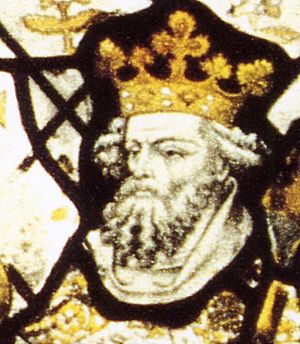
A local story says that King Edgar made Penkridge his capital for three years while he was taking back control of the Danelaw (an area ruled by Vikings). However, most historians say Edgar's reign was peaceful, as his nickname suggests. There are no records of fighting between the English and Danes during his time, so this story is probably not true. Over a century later, in the Domesday Book, Penkridge was still a royal manor, and St. Michael's was a "chapel royal." This means Edgar likely stayed here simply because it was one of his homes. Medieval rulers often traveled with their helpers to use up resources where they were found, instead of bringing them to a single capital city.
Around 1086, the Domesday Book recorded the situation in Penkridge. It also showed how things had changed or stayed the same since Anglo-Saxon times. Penkridge was still owned directly by the king, William the Conqueror, not just by another powerful lord. This was the same as when Edward the Confessor held it before the Norman Conquest. The king owned a mill and a large area of woodland. However, very few people worked on the king's land: just two slaves, two "villeins" (farmers tied to the land), and two smallholders. Even so, the land at Penkridge was worth 40 shillings a year. Then there were the smaller parts of the manor, like Wolgarston, Drayton, Congreve, Dunston, Cowley, and Beffcote. These areas had almost 30 workers and had increased in value from 65 shillings to 100 shillings since the Conquest. This was unusual for the Midlands or North of England at that time.
At Penkridge itself, a large part of the farmland was held from the king by nine "clerics" (church officials). They had a "hide" (an old measure of land) worked by six slaves and seven villeins. These clerics also had another 2¾ hides of land at Gnosall, to the north, with twelve workers. Both these church holdings had greatly increased in value since the Conquest. In the time of King Henry I, there was a disagreement between the Abbey of Saint-Remi in France and a royal chaplain. The abbey claimed the church at Lapley, next to its daughter house, Lapley Priory. It's believed the chaplain was a canon (a type of priest) from Penkridge, trying to prove an old claim to Lapley. A document from the 1200s confirms that Lapley once belonged to Penkridge. The court decided in favor of Saint-Rémy, and Lapley became a small independent parish under the control of the French abbey. This wasn't a direct result of the Norman Conquest but was meant to confirm a grant made to the French abbey by Ælfgar, Earl of Mercia, in the last years of the Anglo-Saxon monarchy.
Penkridge seemed to have gone through the Norman Conquest not only unharmed but also richer and more important. It was a royal manor with a good amount of royal land and a large church staffed by a group of clerics. However, it wasn't a village in the modern sense. Penkridge itself would have been a small settlement on the southern bank of the River Penk. The homes of ordinary people were likely grouped east of the church, along the Stafford-Worcester road, with scattered small farms (hamlets) in the surrounding area.
Medieval Penkridge Life
St. Michael's Collegiate Church
The church was the most important building in Penkridge from late Anglo-Saxon times. By the 1200s, it had a very special setup:
- It was a "chapel royal," meaning it was a place set aside for the king's own use. This made it independent of the local Bishop of Lichfield. This special independence was called a "Royal Peculiar."
- It was a "collegiate church," meaning it was run by a group (a college) of priests. This group was called its "chapter."
- It was organized like a cathedral chapter, which is the governing body of a cathedral.
- It was led by the Archbishop of Dublin.
The college was already well-established by the time of the Norman Conquest. The nine clerics mentioned in the Domesday Book were too many for a small village. They served a wide area of Staffordshire from their base in Penkridge. The priests who belonged to the college were often called "canons," which is the usual name for permanent staff at a cathedral or large church. As a group, they were also known as a "chapter." The chapter continued much the same way after the Norman Conquest as it had in Anglo-Saxon times. Throughout its history, it was made up of "secular clergy" (priests who lived in the world), not monks.
In many ways, St. Michael's, Penkridge, was similar to other important churches nearby, like St. Michael's Collegiate Church at Tettenhall, St. Peter's Collegiate Church, Wolverhampton, and St Mary's College at Stafford. All were chapels royal, organized similarly, and fiercely protected their independence. They formed a strong block within the area of the Diocese of Lichfield. The bishop of Lichfield was the "ordinary," the official responsible for church laws and order in the region. Sometimes, these churches seemed to work together, forming a united front against determined bishops. This was very different from the smaller, local parish churches, which were easier to control.
The church and college lost their independence only during a troubled time called "the Anarchy" during King Stephen's reign. Stephen wanted to gain the church's support for his takeover against Empress Matilda. So, he gave the churches of Penkridge and Stafford to Roger de Clinton, the bishop of Coventry and Lichfield. Some time after the first Plantagenet ruler, Henry II, became king in 1154, Penkridge escaped the bishop's control. By 1180, it was certainly back in the king's possession. In the meantime, it had been reorganized to match the chapter of Lichfield Cathedral, which was set up similarly in the mid-1100s. Like a cathedral, the college was now led by a "Dean." The first dean was named Robert, but little else is known about him. The canons were now "prebendaries," meaning each was supported by money from a specific group of estates and rights (called a "prebend"). This prebend was technically attached to their choir stall, not to them personally. There were prebends for Coppenhall, Stretton, Shareshill, Dunston, Penkridge, Congreve, and Longridge. It's possible that the Penkridge prebend included the lands held by the nine priests mentioned in the Domesday survey. Later, two more prebends were created for two "chantries" (places where prayers were said for the dead). For many decades, Cannock was also a prebend of Penkridge, though the Lichfield chapter strongly argued against this. Cannock seems to have permanently left Penkridge's control in the mid-1300s.
In 1215, the year of Magna Carta, King John gave the right to appoint the dean (called the "advowson of the deanery") to Henry de Loundres, or Henry of London. Henry was a loyal servant of the king and had recently become Archbishop of Dublin. King John was under great pressure from the barons, so he wanted to strengthen his supporters. The Hose or Hussey family had been given the manor of Penkridge some time before. But in 1215, Hugh Hose, the likely heir to the manor, was under King John's care (a "ward"). John convinced him to give the manor to the archbishop, along with Congreve, Wolgarston, Cowley, Beffcote, and Little Onn. These were all considered "members" or parts of Penkridge manor.
The archbishop used this chance to benefit his family and his diocese. He permanently divided the manor into two unequal parts. He gave two-thirds to his nephew, Andrew de Blund. Henry gave the remaining third to the church; this part became known as the deanery manor. The de Blund family, later called Blount, held the manor of Penkridge for about 140 years, eventually selling it to other non-church lords. Along with the prebends and other holdings, the Deanery Manor was meant to fund St. Michael's college for over 300 years. When the newly rich deanery position became empty in 1226, Henry took the opportunity to appoint himself. Although King John's son, Henry III, challenged this by appointing his own dean, the original document was found. This established the rule that the deanery of Penkridge would be held by the archbishops of Dublin, which it was until the Reformation. This was a unique arrangement for Penkridge.
- The Church of St. Michael and All Angels
-
The wrought iron gates of Dutch origin, from 1778. The organ, which used to be in the tower arch, was moved to its current spot in 1881.
Penkridge church had to fight several times to keep its independence from both the Diocese of Coventry and Lichfield and the wider Province of Canterbury (the church province in England). In 1259, the Archdeacon of Stafford tried to conduct a "canonical visitation" (an inspection tour) on behalf of the diocese. Henry III personally wrote to him, ordering him to stop. The Second Council of Lyons in 1274 criticized several problems with the prebendaries of the chapels royal. These included not living in the area and holding multiple church positions ("pluralism"). In 1280, the Archbishop of Canterbury, John Peckham, inspired by the council's rules, tried to visit all the royal chapels within the Coventry and Lichfield diocese. The Penkridge College refused him entry to the church, as did those in Wolverhampton, Tettenhall, and Stafford. The Stafford church even had to be ordered by King Edward I to resist. The canons of Penkridge appealed to the Pope, while Peckham excommunicated them (kicked them out of the church). However, he made sure to exclude John de Derlington, dean of Penkridge and Archbishop of Dublin, from his sentence, as he was his equal. After more than a year of threats and talks, pressure from the king forced Peckham to quietly drop the issue. There were similar arguments throughout the 1300s about whether the pope could appoint canons to prebends at the church. After long and complicated actions, the Crown won around 1380, under Richard II, who was able to benefit from the "Western Schism" (a split in the Papacy). The only major slip-up happened in 1401. Henry IV, who had taken the throne from Richard, relied heavily on the support of Thomas Arundel, then Archbishop of Canterbury. Arundel used this chance to force an inspection of all the royal chapels in Staffordshire, including Penkridge. Every member of the chapter or their deputy was secretly questioned by two of Arundel's officials, and some local people were also questioned. However, there were no major consequences for the college.
Once the deanery was always held by the Archbishops of Dublin, the deans were almost always absent. It seems that most of the canons were also usually away. This was not unusual in collegiate churches; the situation at Wolverhampton was much worse. There was a natural tension between St. Michael's status as a chapel royal and its role as a village church. Kings mainly used their chapels as "chantries"—places where daily prayers and masses were said for the souls of monarchs and the royal family. This would have been the case from the church's founding. By the mid-1300s, there were two priests specifically for this purpose: one for the King's Chantry and one for the Virgin Mary's Chantry. This focus on the dead was just one thing that separated the church from the needs of the local community. It was mainly a national institution, not a local one. Its main purpose was to serve the monarchy, and one way it did this was by offering opportunities for advancement. Appointments to the chapter of a wealthy cathedral or chapel were a way to reward important royal ministers or supporters. So, these appointments were not made with the community's needs in mind, and they were often held along with many similar jobs. Regular worship was conducted by "vicars" and other priests, usually paid by the prebendaries or from special funds. Sometimes, problems and corruption appeared. Royal investigations in 1261 and 1321 found that resident canons tended to misuse the college's property, at the expense of those who were absent. The 1321 inquiry also said the chantry priests were wasting resources. By the late Middle Ages, ordinary people's expectations were rising, and they wanted more involvement in worship. So, by the 1500s, the people of Penkridge were paying for their own "morrow-mass priest," who made sure there was a daily mass for people to attend.
In 1837, the church was separated from its vicarage (the priest's house) by the building of the Grand Junction Railway. A foot tunnel was built under the railway line so the curate (assistant priest) could move between the two. The vicarage, described as "a house of considerable size, with an Italian roof," was made bigger and better at the railway company's expense, as compensation.
Powerful Lords and Manors
Economic and social life in medieval Penkridge happened within the "manor." This was the basic land unit of "feudal society," which controlled the economic and social relationships of its members and enforced laws. A manor sometimes covered the same area as a village, but not always. Penkridge was first a royal manor. This was still true in 1086, when the Domesday Book found that the king had land and a mill at Penkridge directly worked for him by a small team. The situation changed, probably in the 1100s, when a king gave it as a "fief" (land held in return for service) to the Hose or Hussey family. This led to its later grant to Archbishop Henry de Loundres, who divided it into lay (non-church) and deanery manors for his family and church successors. This was not accepted without challenge, and the Husseys occasionally claimed Penkridge until the 1500s. This kind of ongoing dispute was typical of feudal land ownership. However, their actual possessions shrank to a couple of small holdings at Wolgarston. Penkridge manor and the Deanery Manor were not the only manors within Penkridge parish. In fact, there were many, of different sizes and types of ownership.
- The Church of St. Michael and All Angels
-
Tomb of Sir Edward Littleton (died 1558) and his wives, Helen Swynnerton and Isabel Wood. This work is thought to be from the Royley workshop in Burton on Trent.
-
Tomb of Sir Edward Littleton (died 1574) and his wife, Alice Cockayne. The high ruffs they both wear are typical of that period. Also thought to be from the Royley workshop in Burton on Trent.
-
Tomb of two Sir Edward Littletons, father and son. On the east wall of the north chancel aisle. The lower part shows Sir Edward Littleton (died 1610) and his wife Margaret Devereux. The upper part shows Sir Edward (died 1629), and his wife Mary Fisher. Their son, also Sir Edward, became the first baronet in 1627.
Here are some of the different medieval manors and estates:
- Penkridge Manor. This manor passed through the Blund or Blount family. In 1363, John Blount sold it to John de Beverley. John's mother, Joyce, argued against this sale, claiming a third of it back as part of her "dowry" (property a wife brings to a marriage). Eventually, the entire manor was given to John de Beverley. When he died in 1480, it went to his widow, Amice, who lived until 1416. Amice held the manor directly from the king, in return for providing military help (knight service). Amice leased half the manor to Sir Humphrey Stafford of Hook, Dorset, and her heirs sold this land to him. The exact history of the other half is unclear, but Humphrey's grandson, also named Humphrey, seems to have brought the whole manor back under his control and was known as "Lord of Penkridge" in his later years. These Humphrey Staffords were distant relatives of the local de Staffords. The younger Humphrey died in 1461, and Penkridge passed, through his heirs, to Robert Willoughby, 2nd Baron Willoughby de Broke, a respected soldier and courtier of King Henry VIII.
- Penkridge Deanery Manor, held by the Archbishops of Dublin from the 1220s.
- Congreve, which was originally part of Penkridge manor. Even in the 1800s, the lords of Congreve paid a small rent, £1 1s., to the lords of Penkridge. In the 1200s, the Teveray family settled at Congreve, though not without long arguments. By 1302, it was called a manor. In the 1300s, the Dumbleton family bought all the rights from the arguing parties and were soon called de Congreve. The same Congreve family held the manor until modern times, living at Congreve Manor House.
- Congreve Prebendal Manor, which belonged to St. Michael's College. It was centered on Congreve House, about 250 meters from the Manor House.
- Drayton, also originally part of Penkridge manor. The de Staffords held the "overlordship" (the highest claim to the land) from the 1100s, and the Barons Stafford claimed it for centuries. However, Hervey Bagot, who had married Millicent de Stafford, got into long and complicated legal problems over owning Drayton. These were finally solved when all parties agreed to give the manor to the Augustinian priory (a type of monastery) of St. Thomas near Stafford.
- Gailey, which had once been given to Burton Abbey by Wulfric Spot. By the 1100s, the de Staffords were overlords and gave it as a fief to Rennerius. He, in turn, gave it to the nuns of Blithbury priory. It then quickly passed to Black Ladies Priory, Brewood, before the king acquired it around 1189. It then became a "hay" or division of the royal forest of Cannock or Cannock Chase.
- Levedale, which also had the de Staffords as overlords. In the Domesday Book, the tenants were Brien and Drew. For centuries after, the "mesne lords" (intermediate tenants) were descendants of Brien, the de Standon family. In the mid-1100s, the "terre tenant" (the actual resident lord of the manor) was Engenulf de Gresley. He had no sons but divided the manor among his three daughters. This started a series of family disputes, legal arguments, and displays of petty greed that lasted for centuries. For example, around 1272, Amice, widow of Henry of Verdun, a deceased lord of Levedale, kidnapped her own son from the care of the overlord, Robert de Standon. Robert took Amice to court, where she was forced to admit what she had done and was ordered to return young Henry to Robert.
- Longridge, which seems to have belonged to the prebend of Coppenhall, and so was part of the estates of St. Michael's College. However, several small landowners held a large part of it, seemingly as tenants of the prebend.
- Lyne Hill or Linhull, apparently belonging to the deanery, but mainly owned by a family called variously de Linhill, de Lynhull, Lynell, or Lynehill.
- Mitton, which had the de Staffords as overlords and the de Standons as mesne lords, like Levedale. By the mid-1100s, it was owned by a family known as de Mutton. Isabel de Mutton inherited the estate as a baby around 1241 and was taken into the care of Robert de Stafford. The de Standons argued over her care, claiming the de Muttons were their direct tenants at Mitton. They said they were 40 shillings out of pocket because of Robert's high-handed actions. Robert claimed, on the other hand, that the de Mittons held two other properties directly from him. The de Standons argued that their claim was older. After a long argument, Robert de Stafford agreed to hand over the heiress to the de Standons. Later, Isabel married Philip de Chetwynd of Ingestre. He almost lost Mitton during the Second Barons' War. He was accused of helping Ralph Basset of Drayton Bassett to seize Stafford and hold it against a royal army. His estates were taken away, but under the "Dictum of Kenilworth," he was allowed to buy them back from Robert Blundel, who had been given the right to redeem them by the King. He strongly maintained his innocence of all charges. Mitton passed into the estates of the Chetwynd family of Ingestre through Isabel and Philip's son, also named Philip. During her second marriage, to Roger de Thornton, Isabel actively pursued tenants whom she accused of cutting down trees and taking fish from her ponds.
- La More (later Moor Hall), a small manor just west of Penkridge. Its overlord was the church of St. Michael. It returned to the church whenever there was a gap between tenants from the de la More family.
- Otherton, another small manor, old enough to be mentioned in the Domesday Book. In late Anglo-Saxon times, it was held by Ailric. But by 1886, it was part of the de Stafford barony, though held by Clodoan. In the 1200s, the overlordship passed to the de Loges family of Great Wyrley, and in the 1300s, to the lords of Rodbaston, the de Haughton family. The manor was actually held by a local family who took their name from it, the de Othertons, until it passed to the Wynnesbury family of Pillaton in the 1400s.
- Pillaton, a small manor east of Penkridge. The overlord was Burton Abbey, which had received the land from Wulfric Spot in 1044. It was held from the abbey by a series of families and became part of the Wynnesbury lands in the 1400s.
- Preston, which belonged to the College of St. Michael after it was made part of the prebend of Penkridge by a gift from a woman named Avice in the mid-1200s. The canons leased it to a series of tenants, who paid a tithe (a portion of their produce) to the prebend.
- Rodbaston, which also existed before the Norman Conquest. It was held by an Anglo-Saxon free man called Alli in 1066. After belonging for some centuries to the lords of Great Wyrley, it was joined with Penkridge manor in the hands of John de Beverley around 1372.
- Water Eaton, another pre-Conquest manor that came under de Stafford overlordship. They leased it to the de Stretton family, who later became overlords themselves and leased it to sub-tenants. These were the de Beysin family, who got into long arguments with the Crown over their estate encroaching on the royal forest. In 1315, they even petitioned Parliament for an investigation. Eventually, the de Beysins rented out the land and stopped living locally.
- Whiston, which came under the overlordship of Burton Abbey from 1004. One of the tenants, a John de Whiston, fought as a knight at the Battle of Crécy in 1346. Later, the manor faced many lawsuits when a series of short-lived lords of the manor (probably due to the Black Death) left their heirs difficult problems with land ownership.
- Coppenhall or Copehale, now a separate parish from Penkridge, though part of it in the Middle Ages. It was a manor in Anglo-Saxon times. In the Domesday Book, the overlords were the de Staffords, though the tenant was a man called Bueret. His son, Ulpher de Coppenhall, divided the manor in two, bringing in the Bagot family, whose half was called the Hyde. The Bagots seemed to have particularly nasty family disputes. The Staffordshire "Plea rolls" (court records) for 1250 record that Ascira, the widow of Robert Bagot, sued William Bagot, presumably her stepson, for a third of various properties at Coppenhall and the Hyde, and elsewhere, as her "dower" (a widow's share of her husband's property). William replied that Ascira had never been legally married to his father, and the case was sent to the Bishop of Worcester. The Bagots remained at the Hyde until the 1300s, when their family line died out, and the land returned to the de Staffords. Edmund Stafford, 5th Earl of Stafford, died fighting for Henry IV at the Battle of Shrewsbury. The infant heir became the king's "ward" (under royal care), and Henry used this chance to grant part of Coppenhall to his new wife, Joan of Navarre. The rest stayed with the Barons Stafford, who granted it to their relatives, the de Staffords of Hooke, Dorset. After more arguments and complications, it ended up in the hands of Robert Willoughby, 1st Baron Willoughby de Broke.
- Dunston, originally part of Penkridge manor. By 1166, Robert de Stafford was recognized as overlord, and Hervey de Stretton was his tenant at Dunston. However, the de Staffords themselves kept land at Dunston until at least the 1500s. The lordship and most of the land passed down in the de Stretton family for several generations. But by 1285, they were renting most of their land to the Pickstock family, and in 1316, John Pickstock was named as lord of Dunston. The Pickstocks were "burgesses" (citizens of a town) of Stafford and remained lords of the manor for several generations until John Pickstock granted most of his lands to members of the Derrington family in 1437.
- Stretton, also now outside Penkridge parish. Before the Norman Conquest, it had been held by three "thegns" (Anglo-Saxon nobles). But the Domesday Book found it held by Hervey de Stretton under the overlordship of Robert de Stafford. By the 1300s, the Congreve family owned the manor.
The complex way land was owned in feudal Penkridge is clear. The actual farmers, mainly "villeins" (farmers tied to the land) or even slaves, were at the bottom of a social pyramid. This pyramid could have four or five layers below the king at the top. This was because of "subinfeudation," where estates were constantly granted and re-granted, often divided, in return for feudal payments, usually military service. Short life expectancy, especially during wars and plagues, caused constant arguments over who would inherit land. A common complaint was from widows, often neglected by children or step-children, who then started legal action to get back a share of the estate, usually a third. Child heirs fell into the control of the overlord, sometimes the king. The overlord could use the estate unfairly while the child was young and demand a large payment ("feudal relief") when the heir took over. This happened with King John and Henry IV. A lack of a male heir often led to an estate being temporarily or permanently divided among daughters, creating many opportunities for more family arguments. This kind of dispute finally frustrated Hervey Bagot and his rivals, leading them to give Drayton to the Church.
The Staffords were a powerful family with many branches. They had great influence in regional and national affairs, starting from a grant of large estates to Robert de Stafford by William the Conqueror. They were important as both overlords and as actual landowners in the area around Stafford, including Penkridge parish. Below them was a group of middle-level landowners, who often held many properties at different levels in the feudal pyramid. A good example was Hugh de Loges, a baron from the mid-1200s. He was lord of Great Wyrley in Cannock; lord of Lyne Hill in Penkridge, which he probably held from the Penkridge deanery manor; lord of Otherton, where he owed loyalty to the de Staffords; and lord of Rodbaston, which he held by "serjeanty" (service to the king) in Cannock Chase. The Church was a major landowner in Penkridge, and the amount of church land would have important consequences during the Reformation, when church property was taken by the Crown. However, many estates were very small, with minor manor lords struggling to pay their dues and debts.
Even the smallest lord of the manor had great power over his tenants, especially the villeins and others tied to the estate. Typical rights enjoyed by a small manor lord would be those claimed by St. Michael's at La More in 1293:
- View of frankpledge - holding tenants responsible as a group for breaking the law.
- Assize of Bread and Ale - regulating the price and quality of food and drink and fining offenders.
- Infangthief - chasing and punishing offenders within the manor.
A more important landowner, like John de Beverley, in 1372 gained the rights of:
- Outfangthief - transferring offenders caught outside the manor to his own court for quick justice.
- Gallows - the right to carry out capital punishment (death penalty) on offenders.
- Waif and stray - taking possession of any animal found wandering or lost.
From the 1300s, the feudal system in Penkridge, like elsewhere, began to break down. King Edward I's law "Quia Emptores" of 1290 changed the legal system greatly by banning "subinfeudation" (the practice of creating new layers of land ownership). The Black Death and the huge drop in population in the 1300s made labor expensive and land relatively cheap. This encouraged landowners to seek money from rents, which they used to pay for labor. In the 1400s, a new system of cash, goods, wages, rents, and leases developed, bringing big changes in land ownership.
The most important beneficiaries were the Littleton family. Richard Littleton was the second son of Thomas de Littleton, a famous lawyer from Frankley, Worcestershire. Thomas had direct connections to the area, as he had married Joan Burley, widow of the fifth Philip Chetwynd, lord of Mitton. Richard first appears as a tenant and perhaps manager for William Wynnesbury, who owned Pillaton and Otherton in the late 1400s. Richard married Alice, his landlord's daughter, who inherited the estates when William died in 1502. Alice passed them on her death to her son, Sir Edward Littleton. Pillaton Hall, which they rebuilt, was the home of the Littletons for two and a half centuries. From there, they built a property empire, using leases as their main tool. Land leases, typically for twenty years, gave them effective control of larger and larger estates. When the chance to buy land came up, they were in the best position to do so, as an existing lease discouraged other buyers. Richard died in 1518, though Alice lived eleven years longer. They were buried in a table tomb in a new family chapel in St. Michael's church.
The Traditional Economy
Medieval Penkridge was clearly important for the church and for trade, but most of its people depended at least partly on farming for their living. Farming expansion was greatly hindered by the "Forest Law" imposed after the Norman Conquest. This law protected the wildlife and environment for the king's enjoyment through very harsh punishments. Large areas around Penkridge were made part of the Royal Forest of Cannock or Cannock Chase, forming divisions known as Gailey Hay and Teddesley Hay. The forest stretched in a wide arc across Staffordshire, with Cannock Chase bordering Brewood Forest at the River Penk, and the latter extending to meet Kinver Forest to the south. The First Barons' War in the 1200s started a process of gradually loosening these laws, beginning with the first "Forest Charter" in 1217. So, it was during Henry III's reign that Penkridge began to grow economically and probably in population. Local people quickly took any opportunity that arose. In the mid-1200s, there were complaints about "assarting" (clearing trees and scrub to create fields) by residents of Otherton and Pillaton. However, the struggle against the forests was not over. At times, the kings' servants tried to push forward the forest boundaries, especially from Gailey Hay along the southern edge of the parish.
Much of the area was farmed using the "open field system." The names of the open fields and common meadows in Penkridge were recorded for the first time just as they were about to be "enclosed" (fenced off into private plots) in the 1500s and 1600s, though they must have existed throughout the Middle Ages. In Penkridge manor in the early 1500s, the open fields were Clay Field, Prince Field, Manstonshill, Mill Field, Wood Field, and Lowtherne or Lantern Field. In the 1600s, Fyland, Old Field, and Whotcroft were mentioned. Stretton Meadow and Hay Meadow seem to have been common grazing areas, the latter on the right bank of the Penk, between the Cuttlestone and Bull Bridges. The Deanery Manor had at least two open fields, called Longfurlong and Clay Field, the latter perhaps next to the land of the same name in Penkridge manor. In most of the smaller manors, too, open fields are known to have existed. For example, Rodbaston had Low Field, Overhighfield, and Netherfield. Initially, the farmers were mainly "unfree," meaning villeins or even slaves, forced to work on the lord's land in return for their strips in the open fields. However, this pattern would have collapsed from the mid-1300s, as the Black Death drastically reduced the labor supply and, with it, the value of land. In 1535, as the Priory of St. Thomas faced being closed down, its manor of Drayton was worth £9 4s. 8d. annually, and the largest share, £5 18s. 2d., came from rents. This shift from labor service to paying rent was mostly complete by this time, and landlords used the money to hire labor when needed.
There are no detailed records of what was grown in medieval Penkridge. In 1801, when the first record was made, nearly half the land was used for wheat. Barley, oats, peas, beans, and brassicas (like cabbage) were the other main crops. This was probably similar to the medieval pattern: farmers grew wheat wherever the land in their scattered strips supported it, and other crops elsewhere. Cattle grazed on the riverside meadows, and sheep on the heath.
Markets and Mills
Markets could be very profitable for manor lords, but they needed a royal charter (permission from the king) before one could be started. Hugh Hose's grant of Penkridge manor to the Archbishop of Dublin in 1215 included the right to hold an annual fair, though it's not known if Hugh had actually obtained this right. Nevertheless, Edward I recognized Hugh le Blund's right to a fair in 1278, and the grant was confirmed to Hugh and his heirs by Edward II in 1312. John de Beverley got confirmation of the fair in 1364, and it passed down with the manor until at least 1617. The exact date varied greatly, but in the Middle Ages, it fell around the end of September and lasted for seven or eight days. Although it was initially a general fair, it gradually grew into a horse fair.
Henry III granted Andrew le Blund a weekly market in 1244, and John de Beverley also gained recognition for this in 1364. When Amice, John's widow, remarried, the market was challenged as unfair competition to the "burgesses" (townspeople) of Stafford. This was an accusation they often made against markets in the area, including Brewood. Presumably, Amice proved her right to a market because she was able to pass it on to her successors when she died in 1416. For centuries, the market was held every Tuesday. The marketplace was at the eastern end of the town, opposite the church. It is still called "the marketplace," though it is no longer used for that purpose. After 1500, the market declined and eventually stopped. It was revived several times, also changing days. The modern market is a completely new institution on a different site.
Water power was plentiful in the Penkridge area, with the River Penk and several smaller streams able to power mills. Mills are regularly mentioned in land records and wills because they were such a source of profit for the owner. For the same reason, they were a major cause of complaint among tenants, who were forced to use the lord's mill and pay for the service, usually with a portion of their grain. The Domesday Book records a mill at Penkridge itself and another at Water Eaton. A century later, there were two mills at Penkridge, one of them later named the broc mill, likely on one of the streams flowing into the Penk. One of the Penkridge mills was given to William Houghton, Archbishop of Dublin, by the de la More family in 1298. However, it seems the same family continued to operate the mill, as a later archbishop granted them the mill pond for an annual rent of 1d. in 1342. There was a mill at Drayton by 1194, and Hervey Bagot gave it to St. Thomas's Priory along with the manor. Mills are recorded at Congreve, Pillaton, and Rodbaston in the 1200s, at Whiston in the 1300s, and at Mitton in the 1400s. These were all mainly corn mills, but water power was used for many other purposes even in the Middle Ages. In 1345, we hear of a "fulling mill" (used for processing cloth) at Water Eaton, as well as the corn mill.
Reformation and Change: Early Modern Period
The Dissolution of Monasteries
The Reformation brought big changes to life in Penkridge and its parish. It affected not just the church and religious life, but also who owned and controlled everything.
The "Suppression of Religious Houses Act 1535" was meant for monasteries worth less than £200 a year. This included the Priory of St. Thomas, near Stafford, which had owned the manor of Drayton since 1194. As soon as the act passed, Rowland Lee, Bishop of Coventry and Lichfield, wrote to his friend Thomas Cromwell, asking for the priory's lands. The priory only had the prior (head monk) and five canons, but its estates were well-managed and brought in about £180 a year. This was close to the £200 limit and much more than most houses covered by the act. Because of this, the canons were able to bribe their way out of trouble at first, paying £133 6s. 8d. for special "toleration and continuance" (permission to continue). In 1537, they kept sending money to Cromwell, first £60, then £20, and finally asked to be excused from another £20. This was exactly the excuse Lee needed to accuse them of wasting the priory's resources. He asked that the estates be given to him "at an easy rent that the poor boys my nephews may have some relief thereby." The priory was given up in October 1538. Lee immediately moved in and bought large parts of the building materials and livestock for £87. A year later, the rest of the priory property, including Drayton and large estates in Baswich, was granted as a fief to Lee. When he died in 1543, most of it went to his "poor boys," Brian Fowler and three other nephews. Drayton was thus taken from the church and became private property. It stayed with the Fowlers until the Littletons bought it in 1790.
The "Dissolution of the Monasteries" entered its final stage with the "Suppression of Religious Houses Act 1539." The manors of Bickford, Whiston, and Pillaton were technically under the overlordship of Burton Abbey. The abbey had never actually managed these estates, and the manor lords who lived there paid small rents for the land. Sir Edward Littleton (died 1558) had his home at Pillaton Hall, while Bickford and Whiston were held by Sir John Giffard (died 1556) of Chillington Hall, near Brewood. Burton Abbey was given up by its monks early in 1539 after an outbreak of "Iconoclasm" (destruction of religious images). Overlordship of all three manors passed from the abbey to the Crown. The Crown later sold it to Sir William Paget, a moderate Protestant supporter of Protector Somerset during the time King Edward VI was a child. Littleton and Giffard simply started paying their rent to the new overlord, and their families continued to do well throughout the century, even the Giffards despite their Catholic beliefs ("Recusancy").
Edward VI's reign brought a more religious phase of the Reformation. Somerset and then Northumberland pursued increasingly radical policies through the young king. The chantry churches, many of them very wealthy, were disliked by Protestants. A movement to abolish them grew in the final years of Henry VIII. At this point, many chapters tried to make a final profit by selling long leases to private landowners. This is how St. Michael's leased most of its estates to Sir Edward Littleton of Pillaton Hall and his successors for a very long period of 80 years. However, the abolition movement didn't fully happen in Henry's reign, with only a small number of chantries closed under the "Dissolution of Colleges Act 1545." The "Dissolution of Colleges Act 1547," in the new reign, abolished all chantries and their associated colleges.
St. Michael's College was still a busy institution, and its church physically dominated the town more than ever. It was during this period that major rebuilding and changes turned it into the impressive building it is today. The church's estates fully or partly supported the dean (who was still the current archbishop of Dublin), seven prebendaries, two resident canons responsible for the two chantries, an official principal, three "vicars choral" (singing priests), three other vicars, a high deacon, a subdeacon, and a sacrist. Most of the college's lands were leased out to powerful private individuals, mainly to Edward Littleton. His leases included the entire deanery and the college house, as well as the income from the prebends of Stretton, Shareshill, Coppenhall, and Penkridge. In 1547, the college's property was valued at £82 6s. 8d. annually.
The abolition act dissolved the entire college. The Chantries Commissioners, who took over the assets, appointed the first Vicar of Penkridge: Thomas Bolt, a priest from Stafford, who was given £16 per year. The former vicar-choral, William Graunger, became his assistant, on £8. A more distant chapel, in the separate area of Shareshill, was soon also set up as an independent parish church. However, those at Coppenhall, Dunston, and Stretton remained dependent on Penkridge for another three centuries. The college property, still leased and managed by Littleton, was granted by the Crown to John Dudley, Earl of Warwick. Dudley was a key figure in Edward VI's regency council and soon became the most powerful man in the country, with the title Duke of Northumberland. Penkridge's history now became closely tied to the monarchy and the course of the Reformation. Dudley strongly supported Littleton in local property disputes, even though Littleton was religiously conservative. Dudley's local interests matched his rapid rise in national power, which brought him to the top before a quick and disastrous fall.
The Dudley Inheritance
Shortly before he acquired the College lands, Dudley also gained the manor of Penkridge. This happened because of a deal made by Robert Willoughby, 2nd Baron Willoughby de Broke, who owned the manor of Penkridge at the start of the 1500s. In 1507, needing money, he mortgaged Penkridge to Edmund Dudley, King Henry VII's disliked financial agent. In 1510, Dudley was executed by Henry VIII, supposedly for treason, but actually because his extreme unpopularity harmed the monarchy. In 1519, Willoughby mortgaged the manor to George Monoux, a well-known London businessman. He then passed the estate to his co-heirs, his granddaughters, Elizabeth and Blanche. Blanche died soon after, and it became the property of Elizabeth and her husband, Fulke Greville. With debts unpaid, Monoux was able to take over the estate. The situation was complicated by the Dudley family's older claim. In 1539, to solve the problem, Monoux granted the entire manor, likely for a payment, to Edmund Dudley's heir, Robert Dudley, Earl of Warwick. He, in turn, gave it to his son, John Viscount Lisle, and his wife, Anne Seymour, Protector Somerset's daughter.

In addition to the Penkridge manor and the church lands, Dudley also acquired large holdings in the unused lands to the east and southeast. In 1550, he was granted Teddesley Hay, a large area northeast of Penkridge that was now cleared of trees. This was not strictly part of Penkridge, but a separate area because of its history as part of Cannock Chase. Teddesley Hay was undeveloped land, still undrained and unfarmed. As late as 1666, only three households there paid "hearth tax" (a tax on fireplaces). At the same time, he was granted Gailey Hay, another large area of unused land that had been part of the royal forest since King John took it from Black Ladies Priory in 1200.
Dudley went on to overthrow Somerset and have him executed, making himself the unchallenged ruler over the young king and the country. When Edward died in 1553, his sister Mary, a Catholic, was his successor according to both Henry VIII's will and an Act of Parliament. Dudley tried a "coup d'état" (a sudden, illegal takeover of government) to put his Protestant daughter-in-law, Lady Jane Grey, on the throne. Mary gathered her supporters and marched on London. Dudley was quickly arrested, tried, and executed as a traitor. His lands were taken by the Crown. This put the future of large lands at Penkridge in doubt, and it took more than thirty years to finally resolve the situation.
The former St. Michael's church estates were all kept by the Crown as overlord. The Crown also kept the right to appoint the parish priest for the time being. Mary's "Counter-reformation" (her attempt to restore Catholicism) was very limited and not very generous. The monasteries were not brought back, and only Wolverhampton was revived among the chapels royal. St. Michael's College was gone, never to return. The deanery house itself was rented out. The lands were leased, mainly to the Littletons. Penkridge manor belonged to the younger John Dudley, who was arrested and sentenced to death, like his father. He was pardoned, though he lost Penkridge manor and his other lands to the Crown in 1554, and died shortly after being released from prison. His widow, Anne, was allowed to keep a life interest in Penkridge. She remarried only a year later. When she was declared insane in 1566, her second husband, Sir Edward Unton, took control.
The only quick resolution came with Teddesley Hay. After Dudley's execution, his widow was allowed to keep an interest in it, but she died in 1555. It was sold to Sir Edward Littleton of Pillaton Hall. The next Sir Edward, who took over in 1558, was eager to make something of this wilderness. His strong "enclosure" (fencing off) of the area soon upset neighboring landowners and their tenants. Gailey Hay also went to Dudley's widow, but after her death, rights and ownership were sold off bit by bit, creating a complex mix of competing claims that lasted for three centuries.
Mary's Protestant sister and successor, Elizabeth I (1558–1603), passed through Penkridge in 1575; the visit was peaceful. Nothing was done to resolve the situation of the manors of Penkridge. It wasn't until 1581 that the former College property was sold to new owners, granted by the Crown to speculators Edmund Downynge and Peter Aysheton. They sold it only two years later to John Morley and Thomas Crompton, who also sold it very quickly, in 1585, to Sir Edward Littleton. His family had actually managed the land for decades as lessees and seem to have made a fortune from it. Most of the deanery estate stayed with the Littleton family until the 1900s. With the death of Sir Edward Unton in 1582, Queen Elizabeth gave the "reversion" (the right to future possession) of the Penkridge manor to Sir Fulke Greville, son of the Fulke and Elizabeth who had held it in Henry VIII's time. However, Anne Dudley was still alive and could not be removed. Her estates were managed by her son, Edward Unton the younger, until her death in 1588. So, it was not until 1590 that Greville fully owned the manor.
Civil War Times
Greville's main interests were in Warwickshire, around Alcester, rather than in Penkridge. When he died in 1606, his estates passed to his son, another Fulke Greville, a poet and statesman who had served Elizabeth well and would become a key figure in King James I's government. In 1604, James had given him the ruined Warwick Castle, which became his home. He spent most of his attention and much of his money on it. In 1621, he was made the 1st Baron Brooke. He held Penkridge until his death in 1628. Since he was unmarried and childless, he had adopted a younger cousin as his son and heir to the Brooke Barony and most of his estates, including Penkridge manor. This cousin was Robert Greville, 2nd Baron Brooke, an important figure in the parliamentary opposition to King Charles I and in the early stages of the English Civil War.
Robert had strong Puritan beliefs. During the 1630s, when Parliament was not meeting, he encouraged people to move to America, helping to fund the Saybrook Colony. When civil war broke out in 1642, it was clear he would join the parliamentary army. As a very organized person, he quickly became a commanding figure in central England, where loyalties were divided and the war was fought through many sieges and skirmishes. After several victories in Warwickshire in 1643, he moved his forces to Lichfield, where a royalist force had taken refuge in the Cathedral. There, while leading his troops, he was killed by a bullet. However, the succession to the manor was secure. Robert Greville was succeeded by Francis Greville, 3rd Baron Brooke, and Penkridge manor remained with the Grevilles and their Brooke Barony for another century.
Despite seeming to have Puritan sympathies, the Littletons found themselves on the Royalist side. Sir Edward Littleton had been made a "baronet" by Charles I on June 28, 1627. This was in exchange for a large sum of money he got through his marriage to Hester Courten, daughter of Sir William Courten, a very wealthy London textile merchant and financier. He inherited the estates from his father in 1629 and remained loyal to the king throughout the troubles of the 1630s and 1640s. He was a Member of Parliament for Staffordshire from 1640 but was expelled from the House of Commons in 1644. In May 1645, royalist troops were stationed in the village, probably because of Littleton's known royalist sympathies. A small parliamentary force drove out the royalist soldiers after a brief fight. Littleton's estates were subject to "sequestration" (being taken by the government). However, like most minor royalist supporters, he was able to get them back by paying a large sum: £1347. The family's land was thus saved, and the family was back in favor after Charles II was restored to the throne in 1660.
One strange thing left by the years of Reformation and revolution was that the special legal power of the old college of Penkridge was not abolished. Although the church became the center of a large Anglican parish, it was still not absorbed into the Diocese of Lichfield. The lord of the manor took on the role of chief official of this "peculiar jurisdiction." After 1585, this was the head of the Littleton family, always named Edward. For a time, in the late 1600s, the archbishops of Dublin claimed the right of "canonical visitation" (an inspection). This was a weak claim, as their predecessors had been dean, not the main church official, of the church. In the 1690s, the Diocese of Lichfield and Coventry asked Narcissus Marsh, archbishop of Dublin, for permission to visit. Marsh granted permission to Bishop William Lloyd to carry out a visitation of Penkridge. The permission was given to the churchwardens of St. Michael's, who immediately involved Sir Edward Littleton, the second baronet. Littleton wrote back to the bishop. William Walmesley, the chancellor of the diocese, came to Penkridge to look at the documents and became convinced that the Archbishop of Dublin had no right to visit, and therefore no right to give that power to anyone else. Bishop Lloyd then asked Littleton to confirm this and had dinner with him. Nothing more was heard of the matter. The Littletons continued to appoint the vicar and keep the bishop away until the peculiar jurisdiction was abolished in 1858.
The Start of Enclosure
Throughout the 1500s and 1600s, the "enclosure" (fencing off) of open fields, pastures, and unused lands steadily increased. Landowners encouraged this, hoping for higher "productivity" (more crops or animals) and increased land values. The Littletons were early supporters of enclosure. As early as 1534, enclosures were happening in the Deanery Manor, which they leased from the church at that time, though the manor was not fully enclosed until the mid-1700s. Enclosure was not always welcomed by those who lived on and farmed the land. They often lost important grazing rights on common land and feared their scattered plots in the open fields might be replaced by a less desirable plot. It could also create tensions between neighboring landowners.
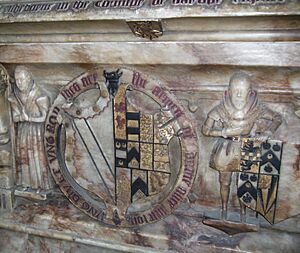
The Littletons carried out major enclosures in Teddesley Hay in the mid-1500s. This wild area was much easier to enclose than the more populated and heavily farmed areas of Penkridge parish. However, there were still arguments with neighboring landowners and with farmers who used the resources of the Hay. In 1561, Henry Stafford, 1st Baron Stafford, complained that Sir Edward Littleton (died 1574) was causing damage there. In 1569, the Earl of Oxford complained that Littleton's enclosures prevented his tenants in Acton Trussell and Bednall from grazing their animals in the Hay and blocked their common path to Cannock Wood and Cannock Heath. The Littletons went on to create a park and a coppice (an area of woodland where trees are cut regularly) in the Hay. In 1675, the people of Penkridge and Bednall demanded that both be opened up. The struggle continued until all common land in the Hay was finally enclosed in 1827.
Enclosure was sometimes welcomed by everyone involved. In 1617, the common fields of the Littleton's manor of Otherton were enclosed by agreement with the people who farmed them. In 1662, in Gailey Hay, where the land was divided into 25 parts owned by several landowners, the landlords agreed to fence the land to allow tenants to farm it for five years, in return for one-seventh of the crop. However, at the end of the 1600s, most of the land in Penkridge and the surrounding manors remained unenclosed, and much of that was still farmed using the "open field system."
Changing Times
The 1700s and 1800s brought huge changes to farming and industry, both locally and across the country. After doing well throughout the Georgian period and especially during the Napoleonic wars (when trade blockades and laws kept grain prices high), farming faced several problems in Victorian times that hit rural areas hard. However, Penkridge's progress was not entirely typical. Population numbers are hard to figure out and understand, but they don't simply show growth followed by a steady decline, as seen in nearby Brewood, for example.
In 1666, the township of Penkridge had 212 households. The rest of the parish probably had fewer than a hundred households in total. A population of 1200 to, at most, 1500 seems a reasonable guess. In 1801, the first census recorded a population of 2,275, a clear increase, and there were just over two hundred more in 1811. After that, the population rose steadily to a peak of 3316 in 1851. The next recorded total, for 1881, shows a considerable drop to 2536. However, this is not directly comparable. The parish was divided in 1866, and the townships of Coppenhall, Dunston, and Stretton became separate parishes. Their total population in 1881 was nearly 600, and all three were declining at that time. Penkridge itself seems to have had a fairly stable population for the century from 1851 to 1951. Of course, the country's population as a whole grew rapidly during this period, so Penkridge's population was relatively declining, and people must have moved to towns. However, the town did not suffer the collapse experienced by nearby settlements.
Farming continued to be the most important employer throughout the Victorian period, though it did decline somewhat and was never completely dominant. The 1831 census collected male employment data at the parish level. It shows 894 adult males working. Of these, 90 were farmers and 394 were agricultural laborers, so farming directly employed almost exactly 60% of the men. The next largest group was those in retail and handicrafts, which accounted for 175. This significant number shows Penkridge's continued importance as a commercial center. These men would mostly live in the town, while the farmers would be much more spread out across the parish. Although the market had stopped, the town must have been full of small shops and workshops.
It wasn't until fifty years later that we get parish-level employment data, this time including women, but it's not directly comparable. 305 of the 638 working men were in agriculture, about 48%, a considerable, though not sudden, drop. The vast majority of women are listed as having an unknown status or not in a specific job. Of those who were employed, 150, the vast majority, were in domestic service. These actually formed the largest single group of employees after agricultural workers. They probably found work with many middle-class families as well as with the wealthy gentry. The hospitality industry seems to have been quite important: forty men are shown as working in food and lodging, a significant number, though not surprising on a major route. Oddly, only one woman is listed in the same trade; almost certainly, many women worked part-time or in family businesses without appearing in the figures. A good proportion of the 15 men working with carriages and horses probably served the inn customers too. The variety of trades is notable. No fewer than 43 people (25 women and 18 men) were involved in dress-making, an important part of any retail center at the time. There were quarrymen, traders, and many others. However, only 14 professionals are listed. Most of these must have been connected with the church and the gentry estates. Although a lively shopping center, Penkridge did not have the large numbers of lawyers and executives typical of county towns and larger market towns.
Penkridge owed much to its transport links, which were always good but steadily improved. The main Stafford-Wolverhampton road, now the A449, was made into a "turnpike" (a toll road) under an Act of 1760. There was a toll gate just north of the Rodbaston turning. Bull Bridge, which carries the road over the Penk, was rebuilt in 1796 and widened in 1822. The improved road quickly attracted traffic, with coaches stopping at Penkridge by 1818 on routes like London-Manchester, Birmingham-Manchester, and Birmingham-Liverpool.
New forms of transport had an even greater impact. The Staffordshire and Worcestershire Canal, designed by James Brindley, opened in 1772. It ran straight through the parish and the township from north to south and was crossed by 15 bridges. There was an important wharf (a loading dock) at Spread Eagle (named after a pub on Watling Street and later called Gailey), and another was later built at Penkridge itself. By the 1830s, boats were calling several times daily, connecting Penkridge to a waterway network that covered almost the entire country. In 1837, the Grand Junction Railway was opened, carried over the River Penk by the impressive seven-arched Penkridge Viaduct, designed by Joseph Locke and built by Thomas Brassey. It cut through Penkridge on its west side, along the edge of the churchyard, where the station was built. Like the canal, the railway also had a stop at Spread Eagle (though Gailey station has since closed). It started with two trains daily in each direction, to Stafford and Wolverhampton. The canal and railway carried both finished goods and raw materials, as well as passengers, and must have played a major part in the town's prosperity.
In the early stages of the Industrial Revolution, iron working along the Penk and its streams received a boost, making iron the town's main industry for a time. As early as 1590, Edward Littleton (died 1610) was looking for a suitable place for a furnace, and there was an iron foundry at Penkridge by 1635. In the early 1700s, a forge at Congreve was producing 120 tons a year, and in the 1820s, the mill below Bull Bridge was used for rolling iron. However, this industry declined as the Black Country ironworks produced more and offered lower prices. After that, "extractive industries" (like mining and quarrying) became more important. By the mid-1800s, the Littletons were operating quarries at Wolgarston, Wood Bank, and Quarry Heath, as well as a sand pit at Hungry Hill, Teddesley, and a brickyard in Penkridge.
The fortunes of the town and the Littletons remained connected throughout the Georgian and Victorian eras. Sir Edward Littleton, the 4th and last baronet, who took over in 1742, completed his family's control of the parish by buying Penkridge manor from the Earl of Warwick in 1749. He soon began work on a new and more impressive home for the family: Teddesley Hall, northwest of Penkridge, on Teddesley Hay. This was built on the site of Teddesley Lodge, a smaller house that had earlier housed younger members of the Littleton family. It was said that the money came from large amounts of coins found behind panels at Pillaton Hall, which brought in a huge sum of £15,000 when sold. The new house was large but plain, a three-story, square, brick building with seven windows on the upper stories on all four sides. The main building was connected by curved walls to side sections, one housing stables, the other kitchens, storage, and servants' rooms.
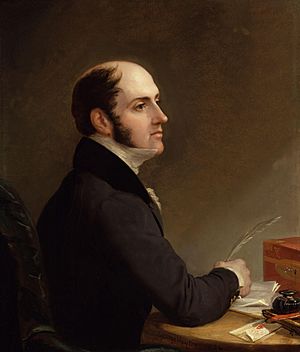
The fourth baronet lived a long life, until 1812, though his wife, Frances Horton, died childless in 1781. In his later life, he represented Staffordshire in Parliament, siding with the Whigs (a political party), who were mostly in opposition during that period. He achieved some recognition, but he never remarried. However, he did secure the succession by adopting his great-nephew, Edward Walhouse, as his heir. Walhouse took the name Littleton and inherited the Littleton estates, though not the Littleton baronetcy. He also took on his great-uncle's parliamentary district, and he would become a far more important politician than any previous or later member of the family. Joining the liberal "Canningite" wing of the Tory party, he strongly campaigned for "Catholic Emancipation" (giving rights to Catholics). When George Canning died in 1827, Littleton joined the Whigs. He was appointed Chief Secretary for Ireland by the Whig Prime Minister Grey in 1833. Ultimately, he found he could not sacrifice his principles for political gain. Having made promises he could not keep to the Irish leader, Daniel O'Connell, he resigned his post. However, he was raised to the peerage as Baron Hatherton, a title that remains with the head of the Littleton family to the present day. Hatherton married Hyacinthe Mary Wellesley, the illegitimate daughter of Richard Wellesley, 1st Marquess Wellesley, and thus a niece of the famous "Iron Duke" (Duke of Wellington). After a long life, he left an heir: Edward Littleton, 2nd Baron Hatherton, another Liberal politician.
However, even the title of the baronage makes it clear that the Littleton family now had land and interests far beyond Penkridge. Hatherton was historically a separate part of Wolverhampton, but became a separate parish in the mid-1800s. The Littletons had a house there as well as land, but they owned much more in Cannock, Walsall, and other parts of Staffordshire. In fact, the first baron had caused a major shift in the family's economic activities. As the heir to a large fortune from the Walhouse family and a successful businessman himself, he had large land and mineral holdings in the Cannock and Walsall areas. The Littleton estates were a part, though an important part, of a wider range of investments. The National Archives list the following property interests of the 1st Baron Hatherton in 1862, a year before his death:
- Teddesley Hall, Woods and Farm; Hatherton Hall, Pillaton Gardens, Teddesley and Hatherton Estate Rentals - all managed by him directly.
- 288 holdings in the following townships: Abbots Bromley, Acton Trussell, Bednall, Beaudesert and Longdon, Bosoomoor, Congreve, Coppenhall, Cannock, Drayton, Dunston, Huntington, Hatherton, Linell, Levedale, Longridge, Otherton, Pipe Ridware, Penkridge, Pillaton, Preston, Stretton, Saredon and Shareshill, Teddesley, Water Eaton, Wolgarston, Walsall Estate Rental.
- 236 holdings in Walsall.
- Royalties from mineral extraction at Hatherton Colliery, Bloxwich; Hatherton Colliery, Great Wyrley; Serjeants Hill Colliery, Walsall; Hatherton Lime Works, Walsall; Walsall Old Lime Works; Paddock Brickyard, Walsall; Sutton Road Brickyard, Walsall; Serjeants Hill Brickyard, Walsall; Butts Brickyard, Walsall; Old Brooks Brickyard, Walsall; Long House Brickyard, Cannock; Rumer Hill Brickyard, Cannock; Penkridge Brickyard; Wolgarstone Stone Quarry, Teddesley; Wood Bank and Quarry Heath Stone Quarries, Teddesley; Gravel Pit, Huntington; Sand Pit at Hungry Hill, Teddesley.
- Tithes (payments) from 579 occupiers in Hatherton, Cannock, Leacroft, Hednesford, Cannock Wood, Wyrley, Saredon, Shareshill, Penkridge, Congreve, Mitton, Whiston, Rodbaston, Coppenhall, Dunston, Bloxwich, Walsall Wood.
This is an impressive list and it clearly shows that the Littletons' interests were shifting towards their profitable mining and quarrying businesses. These were mainly, if not entirely, outside Penkridge, though in nearby towns and villages. The job data in the 1881 census, which show farming still dominant in Penkridge, also show mining even more dominant in neighboring Cannock. There were 2881 men and 17 women mine and quarry workers, most of them employed in Lord Hatherton's businesses. Not surprisingly, Cannock's entire history is very different from its neighbors in Staffordshire. While Penkridge changed to stay stable, and Brewood declined significantly, Cannock grew very rapidly from about the mid-1800s. Cannock parish's population in 1851 was 3,081, a little less than Penkridge's. By 1881, it had risen to an astonishing 17,125. Cannock was a booming town in the early Victorian period, driven by the huge demand for coal from the industrial economy. Walsall was a fast-growing manufacturing center, with money to be made from industrial property and workers' housing. It was here that the second Baron Hatherton made one of the family's largest gifts, Walsall Arboretum, the site of the former lime quarry. Two main roads there are called Littleton Street and Hatherton Street. Significantly, Edward Littleton, who later became the 2nd Baron, pursued his political career as a Member of Parliament for the new Walsall constituency. The Littletons played a leading part in this phase of the Industrial Revolution and made large profits from it. This increasingly shifted their attention away from their farming estates.
Meanwhile, farming remained in a difficult state. The "Long Depression" of the late Victorian period caused farm incomes and rents to fall and sped up migration to industrial towns. The 1900s brought little relief, with only the World Wars giving temporary boosts to farming. The land tax proposals of the "People's Budget" of 1909 were dropped, but it was a warning to large landowners about what was to come. Not surprisingly, those who could, sold off their land. In 1919, the 3rd Lord Hatherton sold large estates in the Penkridge area: over 360 acres (1.46 km²) of the deanery estate; Congreve House and 146 acres (0.59 km²) in Congreve (probably former church property); 368 acres (1.49 km²) in Lower Drayton; 312 acres (1.26 km²) in Upper Drayton; 250 acres (1.01 km²) in Gailey, including the Spread Eagle Inn; 500 acres (2.02 km²) in Levedale; and 340 acres (1.38 km²) in Longridge. In many cases, farms were sold to their tenants. The nationalization of the coal industry in 1946 cut the main link between the family and the area. In 1947, the 4th Lord Hatherton sold some of the land at Teddesley Hay. In 1953, he completed the process, selling over 1520 acres (6.15 km²) at Penkridge and 2,976 acres (12.04 km²) in Teddesley Hay, including Teddesley Hall, the family home. The long dominance not only of the Littleton family, but of the wealthy landowning class as a whole, had finally ended.
The Modern Village
Penkridge in the 1900s and 2000s has followed two paths. On one hand, it has become a place where many people live, like many towns on the edge of the West Midlands urban area. On the other hand, it has remained a market village and an important commercial center.
The growth as a residential area began shortly after the railway arrived. The St. Michael's Road area on the western edge of Penkridge was developed with large Victorian houses and gardens. These homes were for middle-class families who probably worked in Stafford, Wolverhampton, or even Birmingham. The main Stafford-Wolverhampton road was greatly improved between the World Wars, with large parts turned into a "dual carriageway" (a road with two lanes in each direction, separated). The impact was first felt at Gailey, where two stages of widening in 1929 and 1937 took out parts of the churchyard and led to the demolition of the original Spread Eagle Inn. The widening work between 1932 and 1934 brought a major reshaping of Penkridge itself. Early 1800s coachmen considered the Penkridge section the most difficult between London and Liverpool because it was so narrow. The widening swept away up to 30 houses, many of them medieval, on the east side of Clay Street, along with the old George and Fox Inn and a square called Stone Cross on its west side. Initially, this was most important for the improved flow of commercial traffic. After World War II, with many more cars available and in use, it made Penkridge much more suitable as a home for workers employed in the urban area or the county town.
The war itself brought further changes. The old common lands between the Penk and the Cannock Road were used as a military camp during the war years. This made it easier for them to be developed later into a large housing estate, greatly increasing the size and population of Penkridge in the 1950s and 1960s. Between 1951 and 1961, the population grew from 2,518 to 3,383, a rise of over 34% in just ten years.
Improvements in communication continued to drive the village's economy. The M6 motorway came around Stafford in 1962, running north-south between Penkridge and Wolgarston. More importantly, there were junctions just north of Penkridge, at Dunston, and southeast, near Gailey. This gave the village much faster access to the urban area beyond Wolverhampton, as well as to Stoke-on-Trent, Manchester, and the north. The M6 linked to the M1 motorway in 1971, and the long-awaited M54 motorway, following the ancient Watling Street, opened in 1983. This greatly improved links with Telford, Shrewsbury, and much of Wales. Penkridge was now very well placed on a truly national motorway network. Since the arrival of the M6, the population has more than doubled, as new houses have spread along all the roads, particularly north and south along the A449.
Penkridge has remained a significant commercial and shopping center. Major supermarket chains have not been allowed to open stores in the town, and its only large store is a Co-operative supermarket. Independent shops, cafés, inns, and services occupy the area between the old market place to the east and Stone Cross on the A449 to the west. The area between Pinfold Lane and the river, long the site of livestock sales, has become a new market place, attracting many visitors to Penkridge on market days.
Images for kids


